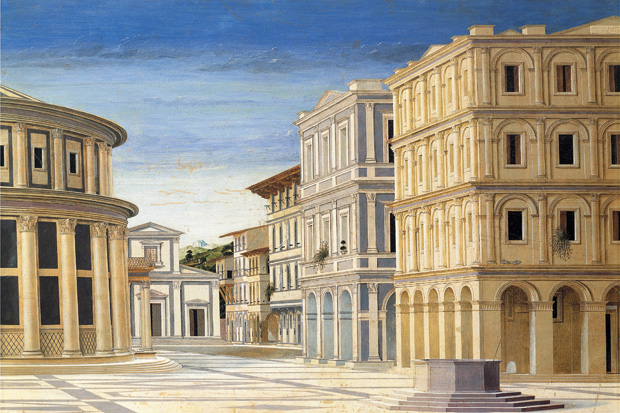When architectural preservationists meet at the tedious conferences and grim councils of despair that feed oxygen to their nihilistic and unventilated ‘heritage’ world-view, the word ‘developer’ is spat out with contempt. It is as though they are speaking of Satan and his diabolical agents, who used to appear in the horror novels of Dennis Wheatley that I so enjoyed in my youth.
To hear Simon Jenkins, for example, refer to a ‘developer’ is to appreciate the impressive range over which the human voice can express contempt. To Jenkins, a ‘developer’ is a loathsome thing bent on profaning all that is sacred. ‘Developers’ despoil the countryside and debauch the city. They are cruel and ignorant exploitationists whose motivation is greed and whose business is corrupt and corrupting. They are merchants whose trade is ugliness.
I wonder if this is altogether true. Surely there is a more generous view of what a developer might be? The Town and Country Planning Act of 1990 offers a forensic definition: ‘the carrying out of building …or the making of any material change to a building’. These seem admirable and inoffensive objectives. True, keeping the company of Alfred Taubman, Harry Helmsley and Harry Hyams might have brought even Mother Teresa into disrepute, but are there not other more positive examples?
The Ideal City, the optimum design for an agglomeration of buildings, has been a preoccupation of civilised life since Plato. It was best realised, perhaps, in the Italian Renaissance. The rustic Tuscan town of Corsignano, near Montepulciano, was rebuilt according to this vision by Pope Pius II. It became known as La Città del Pio and is now called Pienza. With its elegant spaces and fine architecture inspired by Alberti, it can reasonably claim to be one of the most beautiful man-made environments on earth. Wasn’t this property development?
In London, a persuasive champion of high-density new-build was Nicholas Barbon. The author of A Discourse of Trade (1690) made his fortune from rebuilding London after the Great Fire. It was a speculative and daring property development and most of us who admire Red Lion Square are grateful for his efforts. Barbon, confident rather than afraid of change, wrote that new buildings are ‘the most proper and visible distinction of Riches and Greatness because the expenses are too great for Mean Persons to follow’.
Of course, too many ‘Mean Persons’ have been snared by the profitable lure of spec-building. Whether it is a builder-boyfriend knocking through a shabby late-Victorian two-up two-down with lots of plasterboard and Ikea cupboards or a gross plc putting degrading features on stupid boxes to lure credulous rubes with architectural crapola, without question some of the nastiest, most artless and heartless kitsch, some of the most inhuman and cynical travesties of architecture have been made by developers.
Then, again, you have Bedford Square in Bloomsbury. You have the legacies of Portman and Cavendish. Here is the apogee of great city-building and it was what Sir John Soane called the very ‘spirit of speculation’.
What was John Nash if not an inspired property developer? Regent’s Park is one of the planet’s most wonderful urban spaces and it was property development of a spectacular sort. It was built on a scale and with a conviction which, if imitated today, would excite deafening keening and moaning from the heritage lobby.
The problem with demonising contemporary property developers, as the heritage lobby insists on doing, is that the consequence is the same as in the case of the scolding wife. If you are routinely called a lousy, drunken, two-timing, useless bastard there is little incentive for you to be anything better.
Moaning is intellectually lazy and counterproductive. A better attitude is needed. For example, most cities have a ‘development control’ function in their planning departments. This, as the architect David Chipperfield says, makes development seem the equivalent of the vermin and criminals that also need controlling. Positivism will get a better result than negativism.
Currently, most anti-developer rhetoric is directed at the South Bank littoral between Lambeth and Chelsea, where itinerant ‘foreign’ investors are buying apartments that will stay dark and lifeless owing to their owners’ incessant global excursions. But maybe, just maybe, that is the way world cities will develop. And if London wants to remain the leading world city, it needs to negotiate terms with the psychological and practical realities of that status.
If there is a nomadic class of investors, let’s build them the best possible investment-grade properties, not sit around gnashing and mewling about the lost days of wassailing, honey and crumpets or cider-soaked dancing in felt leggings around maypoles. We need an articulate engagement with developers and investors so as to force up standards. We do not want frivolous, mis-placed sentiment or terminal Nimbyism.
That first developer, Nicholas Barbon, created a ‘new method of building’. And it was speculative. It created a ‘super-foetation of houses in London’. Jolly good. We now daily thrill to the enduring results of his new methods. Only the most hopeless pessimist would deny that great developers’ architecture is a future possibility. Besides, property development is the ‘chiefest Promoter of Trade’. That’s jolly good too. We don’t need less property development. We just need better. Ideal Cities are not made by moaners.





Comments
Comments will appear under your real name unless you enter a display name in your account area. Further information can be found in our terms of use.